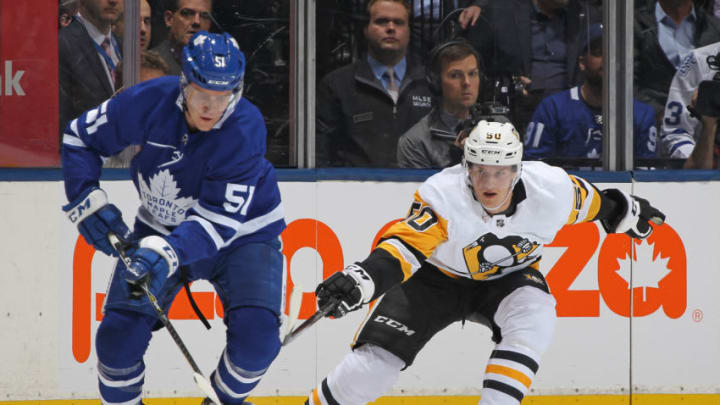Jake Gardiner as a member of the Pittsburgh Penguins was a pipe dream at best. But he would have been perfect for them.
Due to a lack of salary cap space and a logjam on defense, Jake Gardiner signing with the Pittsburgh Penguins was always a longshot and unlikely to happen.
However, as Gardiner remained unsigned as the summer went on, Pittsburgh should have taken a more proactive approach in creating the salary cap and roster space to make signing the offensive defenseman more of a possibility. Granted, accomplishing this would have required a couple of trades to clear cap space, but he would have been worth it.
Last Friday, Gardiner wound up signing a four-year, $16.2 million dollar contract with the Metro Division rival Carolina Hurricanes. He was projected (and deserving) of a larger contract. The longer he went unsigned, the more unlikely he was to get that more lucrative offer.
The rest of the NHL really missed out on a bargain here. As Ryan Stimson points out below, Carolina’s front office is very analytically inclined, and they just made their already-elite defense core even better.
More from Puck Prose
- Detroit Red Wings 2023 Rookie Camp Has Plenty of Ups and Downs
- This Columbus Blue Jackets rookie doesn’t want to be forgotten
- 2 trades the Boston Bruins must make to secure the Stanley Cup
- 3 reasons the Avalanche won’t win the Stanley Cup in 2024
- This is a big year for Alex Turcotte and the Los Angeles Kings
Acquiring players at a modest expense is a very smart strategy. A lot of it requires recognizing the situation and knowing the percentages and career norms for players. They are essentially low-risk, high-reward acquisitions. Since the departure of Jason Botterill in the spring of 2017, the Penguins have really cut back on this method of roster construction.
Back in 2016, Penguins General Manager Jim Rutherford bought low on guys like Trevor Daley, Carl Hagelin, and Justin Schultz. All three of these players helped shift the identity of the Penguins to speed and skill, and contributed to a couple of championships.
The most recent example of Pittsburgh buying-low on a player was when Tanner Pearson (a career 11.6% shooter) was acquired after shooting 0% in 17 games with the Kings last season.
Regardless of what kind of data you look at, Gardiner is a legitimate top-four defenseman. During his time as a Toronto Maple Leaf, the team controlled 51% of the even-strength shot attempts with him on the ice, and he averaged 36 points per season.
Jake Gardiner (4x4m with Carolina) is a solid first or second pair defender. pic.twitter.com/JRiLzHAJvH
— Micah Blake McCurdy (@IneffectiveMath) September 6, 2019
It is also noteworthy that Gardiner and Justin Schultz were teammates at the University of Wisconsin during the 2010-11 season, when both of them averaged more than a point per game. Obviously that kind of offensive pace is not what they are today, but both have developed into very good, offensively-minded NHL blue-liners
Had the Penguins of signed Gardiner, their defense core would probably have looked something like this.
- Brian Dumoulin – Kris Letang
- Gardiner – Schultz
- Marcus Pettersson – Erik Gudbranson
In my opinion, that kind of blueline would have made the Penguins legitimate Stanley Cup contenders again. Five of the six players listed here have the proper mobility, vision, and puck skills to feed the Penguins transition game.
Those pairs also would have allowed Pettersson and Gudbranson to pick up where they left off after a strong finish to last season. Gardiner also has experience quarterbacking the Maple Leafs powerplay, so at the very least he would have added depth there as well.
Divisional foes Carolina, New Jersey, and the New York Rangers have all thoroughly improved their rosters this off-season. If the Penguins want to keep pace and start improving they need to go back to making analytically inclined player acquisitions. After all, there is a history of those kinds of roster decisions really paying off in Pittsburgh. Thanks for reading!
